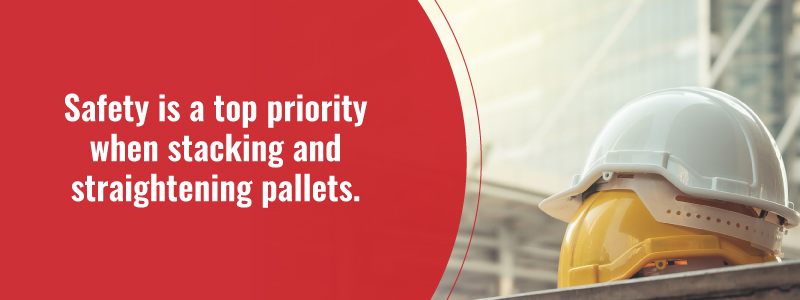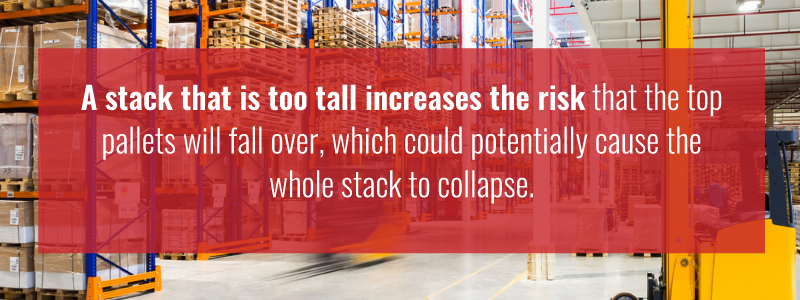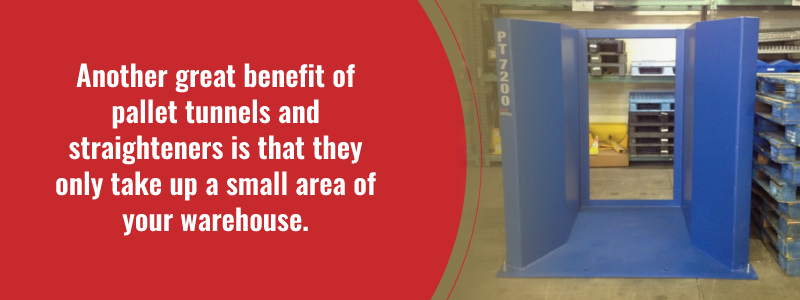Why Is Proper Pallet Straightening Crucial for Warehouse Safety?

Did you know that over two billion pallets are in use across the United States? These pallets, whether made of wood, plastic, or metal, are the unsung heroes of manufacturing, transportation, and material handling industries. In fact, approximately 80% of all goods in the U.S. are transported on pallets. But here’s the kicker: improper pallet stacking and straightening can lead to serious safety hazards, inefficiencies, and even costly accidents. Let’s dive into why proper pallet straightening is non-negotiable and how you can master it.
What Happens When Pallets Aren’t Stacked Straight?
Stacks of pallets that are crooked or uneven are more than just an eyesore—they’re a ticking time bomb. When pallets are stacked haphazardly, they take up more space, making it harder to store inventory efficiently. Worse yet, unstable stacks can collapse, causing damage to your warehouse, inventory, and, most importantly, your workers.

Imagine this: a stack of pallets topples over, crushing valuable inventory or injuring a worker. The financial and human costs of such an incident are staggering. That’s why proper pallet straightening isn’t just about aesthetics—it’s about safety, efficiency, and maximizing your warehouse space.
What Are the Most Common (and Dangerous) Pallet Straightening Mistakes?
1. Using a Wall to Straighten Pallets: A Recipe for Disaster
One of the most common—and riskiest—methods of straightening pallets involves using a forklift to push a stack against a wall. While this might seem like a quick fix, the risks far outweigh the benefits.
Forklifts are powerful machines, but they’re not designed for this kind of work. Pushing pallets into a wall can damage the wall, the pallets, or even the forklift itself. And let’s not forget the potential for injury to the operator or nearby workers. With over 95,000 forklift-related injuries reported annually, it’s clear that this method is a gamble you don’t want to take.

2. Manual Pallet Straightening: A Time-Consuming Hazard
Another risky approach is manually straightening pallets by hand. Not only is this method time-consuming, but it also puts workers at risk of injury. Crushed hands, feet, and even back injuries are common when workers attempt to handle heavy pallets without the right equipment. Plus, the time spent manually straightening pallets could be better spent on more productive tasks.
How Can You Safely Straighten Pallets?
1. Start with a Solid Foundation
Before you even think about straightening your pallets, ensure the stack has a stable base. A weak foundation can lead to instability, no matter how well you straighten the stack. Always inspect the bottom pallets for damage or weakness.
2. Stack Identical Pallets Together
Mixing pallets of different sizes is a recipe for disaster. When pallets are the same size, weight is distributed evenly, reducing the risk of the stack tipping over. If you must stack different-sized pallets, always place the largest one at the bottom and work your way up to the smallest.
3. Limit the Height of Your Stacks
While it might be tempting to stack pallets as high as possible, this increases the risk of collapse. A tall stack is more likely to topple, especially if it’s not perfectly straight. Keep your stacks at a manageable height to minimize risk.

4. Remove Damaged Pallets
Damaged pallets are a safety hazard. Splintered wood, exposed nails, or broken plastic can injure workers or cause instability in the stack. Always remove damaged pallets before stacking or straightening.
5. Use the Right Equipment
The key to safe and efficient pallet straightening is using the right tools. A pallet straightener or pallet tunnel is essential for this task. These devices ensure that your pallets are straightened quickly and safely, without the need for manual labor or risky forklift maneuvers.

What’s the Correct Process for Straightening Pallets?
- Ensure the stack is stable: Before moving the stack, make sure it’s secure and won’t topple over.
- Lift the stack carefully: Use a forklift or pallet jack to lift the stack slowly and steadily.
- Move the stack to the straightener: Transport the stack to the designated straightening area.
- Feed the stack into the straightener: Insert the stack into the pallet straightener or tunnel, ensuring it’s aligned properly.
- Repeat as needed: For larger stacks, you may need to repeat the process to achieve perfect alignment.
- Store the straightened stack: Once the stack is straight, move it to a safe storage location.
What Are the Dos and Don’ts of Pallet Straightening?
Do:
- Stack pallets of the same size.
- Limit stack height to prevent collapse.
- Remove damaged pallets before stacking.
- Use a pallet straightener or tunnel.
- Train workers on proper equipment use.
Don’t:
- Push pallets into walls with a forklift.
- Manually straighten large stacks by hand.
- Overload equipment beyond its capacity.
- Stack pallets near valuable inventory.
How Can You Improve Safety and Efficiency?
One of the best ways to enhance safety is by reducing manual labor. Pallet straighteners and tunnels automate the process, minimizing the risk of injury and freeing up your workforce for more productive tasks. These machines also reduce the risk of contamination, which is especially important in industries like food and pharmaceuticals.

What Are the Benefits of Pallet Tunnels and Straighteners?
Pallet tunnels and straighteners are game-changers for warehouse efficiency. They save time, reduce labor costs, and maximize storage space. Plus, they ensure that your pallets are stored safely and securely, reducing the risk of accidents and damage.
Final Thoughts: Why Invest in Proper Pallet Straightening?
Proper pallet straightening isn’t just about keeping your warehouse tidy—it’s about protecting your workers, your inventory, and your bottom line. By investing in the right equipment and following best practices, you can create a safer, more efficient workspace that maximizes productivity and minimizes risk.
So, what’s your next step? Evaluate your current pallet-straightening process and identify areas for improvement. Whether it’s upgrading your equipment or retraining your staff, every small change can make a big difference. Your warehouse—and your workers—will thank you.


